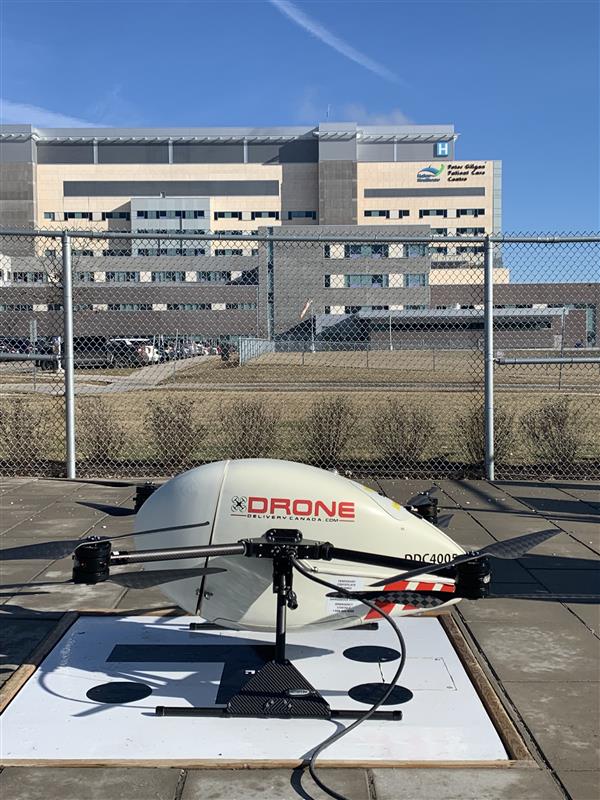DroneCare Project
Frequently Asked Questions
6 months
The project will take a phased implementation. At first, the drone will carry supplies and "dummy" samples standing in for real test samples and medications. Once early flights are successful, the project can transition to transporting "real" lab samples and medications.
DroneCare is a collaboration between Halton Healthcare, DDC & Air Canada Cargo.
Yes. If weather and other conditions permit, drone flights will take place between 9:00am and 4:00pm, Monday to Friday.
The drone does not have any cameras for surveillance technology on it. However, it is equipped with a camera used for precision landing purposes only. Security cameras are mounted at both landing sites (DroneSpot™), pointing only at the landing area. The video feed will be monitored by the Operations Control Centre to ensure the take-off/landing area is clear of both people and wildlife prior to take-off/landing.
The drone will fly on a pre-programmed and fixed flight path designed to avoid flying over people or buildings.
The drone will fly at approximately 72 km per hour.
The 10.7km route will take approximately 13-15 minutes depending on weather conditions.
Approximately350 feet above the ground, depending on terrain elevations.
The drone can carry up to 10lbs (4.5kgs).
The drone can operate in weather conditions that include light rain, snow and wind, and within temperatures of -20 to +40 degrees Celsius.
The system safely runs unmanned, automatically and is monitored from the DDC Operations Control Centre in Vaughan, Ontario, all in compliance with government regulations.
The drone and landing site (DroneSpot™) communicate over multiple channels of communication including cellular signals and VHF frequency.
- Safety Pilot: There is one Safety Pilot at each landing site. The safety pilot is present to ensure everything is operating as designed and can take over if necessary. All safety pilots are holders of Transport Canada's Advanced Certificate.
- Visual Observer: This person is a trained crew member who assists the pilot in ensuring the safe operation of a flight under visual line-of-sight. The Visual Observer will be positioned outside at a location where they can see the drone during the entire duration of its flight between Milton District Hospital and Oakville Trafalgar Memorial Hospital.
- Cargo / drone handler: One cargo / drone handler will be located at each landing site. They are responsible for bringing cargo to the landing sites (DroneSpots™), loading and unloading cargo into the drone, and may perform pre-flight inspections and other maintenance tasks as applicable. For this project, this role is combined with the Safety Pilots.
Generally, the drones fly well below altitudes of other types of manned aircraft. However, DDC’s system constantly monitors all commercial aircraft activity, and manned aircraft always have the right of way.
Yes. All operations are conducted in accordance with the Canadian Aviation Regulations and Transport Canada flight authorizations.
Past projects similar to this one have not experienced any negative interactions between drones and local wildlife. Generally, given the relatively large size of DDC's Canary drone, birds and other small animals typically stay clear of the drone while it is in flight. The drone flies at a low enough speed that birds can be avoided if necessary. Additionally, security cameras are mounted at both landing sites (DroneSpot™), pointing only at the landing area. The video feed will be monitored by the Operations Control Centre to ensure the take-off/landing area is clear of both people and wildlife prior to take-off / landing.
There are a number of technical failsafe procedures built right into the drone’s design. In the unlikely event of an incident involving the drone, Drone Delivery Canada, as the operator of the service, has an established Emergency Response Procedure. DDC coordinates the response with local agencies to ensure a comprehensive safety response plan, should it be required.
Further, in order to minimize the impact of the drone, the flight path has been designed to avoid flying over people or buildings. As an additional safety measure, the complete flight route is designed with pre-determined safe landing zones in the event that the drone is unable to complete the full flight route. In the unlikely event of a drone failure, the DDC crew on-site is trained to safely retrieve the drone.
The cargo (material/specimen) that will be transported is packaged in a secure "Type A" packaging specially designed to transport such specimens. The package would be retrieved by a trained DDC staff member and delivered to the appropriate individual.
Please send any questions to info@dronedeliverycanada.com
Get In Touch
If you have any questions, please don’t hesitate to call us at 647-476-2662 or reach out to us at sales@dronedeliverycanada.com



